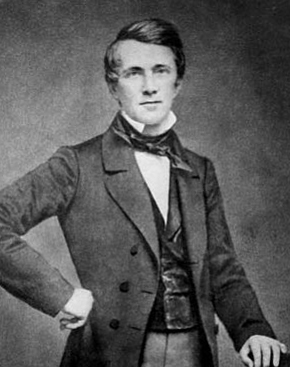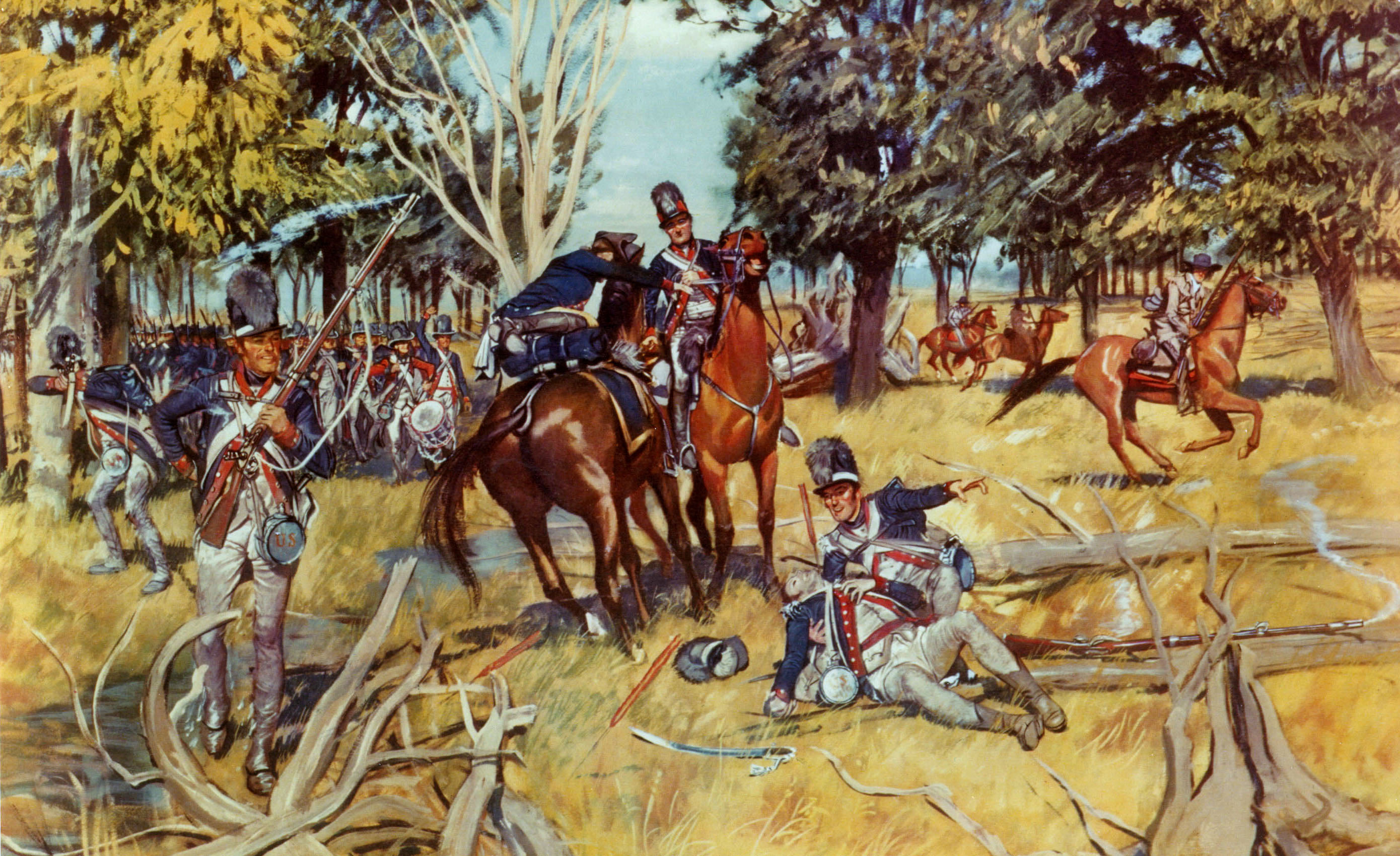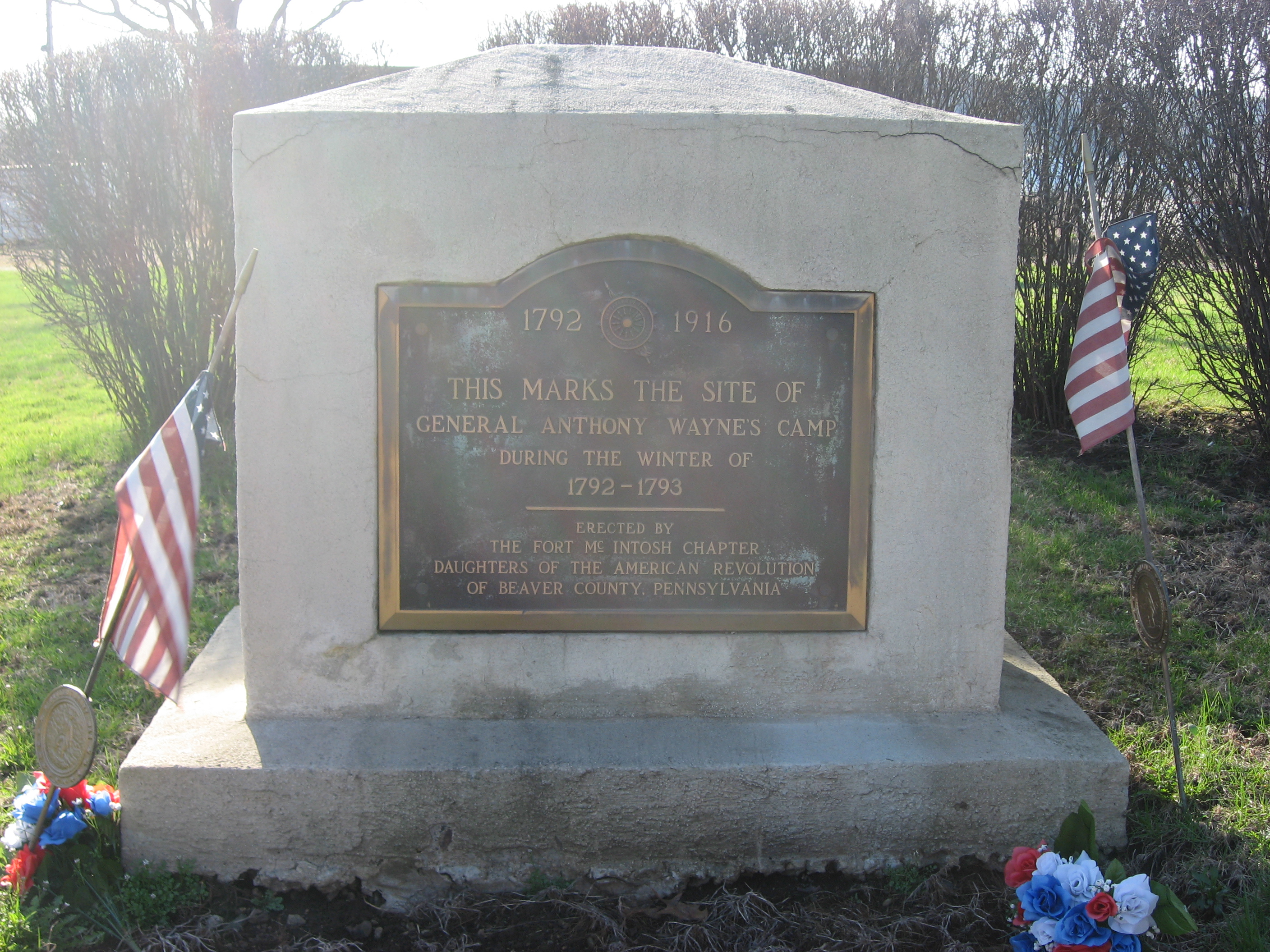|
Ephraim Kibbey
Ephraim Kibbey (1754 or 1756 – 1809) was a United States soldier in the American Revolution, a frontiersman and early settler of Ohio, the leader of Mad Anthony Wayne's famous forty scouts in the Northwest Indian War, and a member of the 1st Ohio General Assembly. He was a contemporary of Daniel Boone, Simon Kenton, and Simon Girty, and what Daniel Boone was for Kentucky, Kibbey and his fellow pioneer, Benjamin Stites, were to early southwest Ohio. Family and early life Ephraim Kibbey was a descendant of Edward Kibbe (born 1597 or 1611, died November 1694), an early settler of the Massachusetts Bay Colony, who immigrated from England about 1639. Noted activities Ephraim enlisted in 1777 at Essex, New Jersey in the Continental Army. He endured the brutal winter of 1777-1778 at Valley Forge with George Washington under the command of Capt. Jacob Martin in General William Marshall's 4th New Jersey Regiment and was eventually assigned to Capt. Seth Johnson's company of the 3rd N ... [...More Info...] [...Related Items...] OR: [Wikipedia] [Google] [Baidu] |
Somers, Connecticut
Somers is a town in Tolland County, Connecticut. The population was 10,255 at the 2020 census. The town center is listed by the U.S. Census Bureau as a census-designated place (CDP). In 2007, ''Money Magazine'' listed Somers 53rd on its "100 Best Places to Live", based on "economic opportunity, good schools, safe streets, things to do and a real sense of community." Bordering Massachusetts, Somers is considered part of the city of Springfield, Massachusetts NECTA. Somers is southeast of Springfield and considered more oriented toward it than the city of Hartford, which lies to the southwest. History Somers was originally part of the Agawam Plantation in the 17th century. Agawam Plantation became Springfield, Massachusetts, in 1641 and in 1682, the Enfield Parish broke off from the Springfield settlement. In 1689, the first settler, Benjamin Jones, came to Somers in what was then East Enfield about a half mile from the current town center, it was only a summer house and in the ... [...More Info...] [...Related Items...] OR: [Wikipedia] [Google] [Baidu] |
4th New Jersey Regiment
The 4th New Jersey Regiment was raised on September 16, 1776, at Elizabethtown, New Jersey, for service with the Continental Army. The regiment would see action at the Battle of Brandywine, Battle of Germantown and the Battle of Monmouth. The regiment was disbanded on February 7, 1779, at Elizabethtown, New Jersey. References * * External linksBibliography of the Continental Army in New Jerseycompiled by the United States Army Center of Military History The United States Army Center of Military History (CMH) is a directorate within the United States Army Training and Doctrine Command. The Institute of Heraldry remains within the Office of the Administrative Assistant to the Secretary of the Arm ... {{NJLine Military units and formations established in 1776 Military units and formations disestablished in 1779 New Jersey regiments of the Continental Army 1776 establishments in New Jersey ... [...More Info...] [...Related Items...] OR: [Wikipedia] [Google] [Baidu] |
1756 Births
Events January–March * January 16 – The Treaty of Westminster is signed between Great Britain and Prussia, guaranteeing the neutrality of the Kingdom of Hanover, controlled by King George II of Great Britain. *February 7 – Guaraní War: The leader of the Guaraní rebels, Sepé Tiaraju, is killed in a skirmish with Spanish and Portuguese troops. * February 10 – The massacre of the Guaraní rebels in the Jesuit reduction of Caaibaté takes place in Brazil after their leader, Noicola Neenguiru, defies an ultimatum to surrender by 2:00 in the afternoon. On February 7, Neenguiru's predecessor Sepé Tiaraju has been killed in a brief skirmish. As two o'clock arrives, a combined force of Spanish and Portuguese troops makes an assault on the first of the Seven Towns established as Jesuit missions. Defending their town with cannons made out of bamboo, the Guaraní suffer 1,511 dead, compared to three Spaniards and two Portuguese killed in battle. * Febr ... [...More Info...] [...Related Items...] OR: [Wikipedia] [Google] [Baidu] |
Territorial Governor Of Arizona
The governor of Arizona is the head of government of the U.S. state of Arizona. As the top elected official, the Governor (United States), governor is the head of the Executive (government), executive branch of the Government of Arizona, Arizona state government and is charged with faithfully executing state laws. The governor has the power to either approve or veto bills passed by the Arizona State Legislature; to convene the legislature; and to grant pardons, except in cases of impeachment. The governor is also the commander-in-chief of the state's Arizona National Guard, military forces. Twenty-three people have served as governor over 27 distinct terms. All of the repeat governors were in the state's earliest years, when George W. P. Hunt and Thomas Edward Campbell alternated as governor for 17 years and, after a two-year gap, Hunt served another term. One governor, Evan Mecham, was successfully impeached, and one, Fife Symington, resigned upon being convicted of a felony. The ... [...More Info...] [...Related Items...] OR: [Wikipedia] [Google] [Baidu] |
Joseph Henry Kibbey
Joseph Henry Kibbey (March 4, 1853 – June 14, 1924) was an American attorney who served as Associate Justice of the Arizona Territorial Supreme Court from 1889 to 1893 and Governor of Arizona Territory from 1905 to 1909. His legal career is most remembered for his efforts in the area of water law, his key legal contributions being the "Kibbey Decision", a legal ruling establishing the principle that "water belongs to the land", and creation of the legal framework for the Salt River Valley Water User's Association, a model for federal water projects in the American West. As governor, Kibbey was a leader in the effort to prevent Arizona and New Mexico territories from being combined into a single U.S. state. Early life Kibbey was born on March 4, 1853 in Centerville, Indiana to Caroline (Cunningham) and John F. Kibbey. His father was an attorney who had been in a legal partnership with Indiana Governor Oliver P. Morton and served as Indiana Attorney General from March to Novemb ... [...More Info...] [...Related Items...] OR: [Wikipedia] [Google] [Baidu] |
Indiana Attorney General
The Indiana Attorney General is the chief legal officer of the State of Indiana in the United States. Attorneys General are chosen by a statewide general election to serve for a four-year term. The forty-fourth and Attorney General is Todd Rokita. The annual salary of the Attorney General of Indiana is $97,201.78. List of Indiana Attorneys General Territorial State Under the 1816 Constitution of Indiana The Constitution of Indiana is the highest body of state law in the U.S. state of Indiana. It establishes the structure and function of the state and is based on the principles of federalism and Jacksonian democracy. Indiana's constitution is su ... the office of Attorney General was filled by appointment. After the adoption of the 1851 constitution, the office was filled by popular election. ;Parties See http://www.in.gov/library/3239.htm, a list of historic Attorneys General compiled by staff of the Indiana State Library. Notes External links Indiana Attorney Gen ... [...More Info...] [...Related Items...] OR: [Wikipedia] [Google] [Baidu] |
John F
John is a common English name and surname: * John (given name) * John (surname) John may also refer to: New Testament Works * Gospel of John, a title often shortened to John * First Epistle of John, often shortened to 1 John * Second Epistle of John, often shortened to 2 John * Third Epistle of John, often shortened to 3 John People * John the Baptist (died c. AD 30), regarded as a prophet and the forerunner of Jesus Christ * John the Apostle (lived c. AD 30), one of the twelve apostles of Jesus * John the Evangelist, assigned author of the Fourth Gospel, once identified with the Apostle * John of Patmos, also known as John the Divine or John the Revelator, the author of the Book of Revelation, once identified with the Apostle * John the Presbyter, a figure either identified with or distinguished from the Apostle, the Evangelist and John of Patmos Other people with the given name Religious figures * John, father of Andrew the Apostle and Saint Peter * Pope Jo ... [...More Info...] [...Related Items...] OR: [Wikipedia] [Google] [Baidu] |
Vincennes, Indiana
Vincennes is a city in and the county seat of Knox County, Indiana, Knox County, Indiana, United States. It is located on the lower Wabash River in the Southwestern Indiana, southwestern part of the state, nearly halfway between Evansville, Indiana, Evansville and Terre Haute, Indiana, Terre Haute. Founded in 1732 by French fur traders, notably François-Marie Bissot, Sieur de Vincennes, for whom the Fort was named, Vincennes is the oldest continually inhabited European settlement in Indiana and one of the oldest settlements west of the Appalachian Mountains, Appalachians. According to the 2010 census, its population was 18,423, a decrease of 1.5% from 18,701 in 2000. Vincennes is the principal city of the Vincennes, IN Micropolitan Statistical Area, which comprises all of Knox County and had an estimated 2017 population of 38,440. History The vicinity of Vincennes was inhabited for thousands of years by different cultures of Indigenous peoples of the Americas#Migration into th ... [...More Info...] [...Related Items...] OR: [Wikipedia] [Google] [Baidu] |
Indiana
Indiana () is a U.S. state in the Midwestern United States. It is the 38th-largest by area and the 17th-most populous of the 50 States. Its capital and largest city is Indianapolis. Indiana was admitted to the United States as the 19th state on December 11, 1816. It is bordered by Lake Michigan to the northwest, Michigan to the north, Ohio to the east, the Ohio River and Kentucky to the south and southeast, and the Wabash River and Illinois to the west. Various indigenous peoples inhabited what would become Indiana for thousands of years, some of whom the U.S. government expelled between 1800 and 1836. Indiana received its name because the state was largely possessed by native tribes even after it was granted statehood. Since then, settlement patterns in Indiana have reflected regional cultural segmentation present in the Eastern United States; the state's northernmost tier was settled primarily by people from New England and New York, Central Indiana by migrants fro ... [...More Info...] [...Related Items...] OR: [Wikipedia] [Google] [Baidu] |
Battle Of Fallen Timbers
The Battle of Fallen Timbers (20 August 1794) was the final battle of the Northwest Indian War, a struggle between Native American tribes affiliated with the Northwestern Confederacy and their British allies, against the nascent United States for control of the Northwest Territory. The battle took place amid trees toppled by a tornado near the Maumee River in northwestern Ohio at the site of the present-day city of Maumee, Ohio. Major General "Mad Anthony" Wayne's Legion of the United States, supported by General Charles Scott's Kentucky Militia, were victorious against a combined Native American force of Shawnee under Blue Jacket, Ottawas under Egushawa, and many others. The battle was brief, lasting little more than one hour, but it scattered the confederated Native forces. The U.S. victory ended major hostilities in the region. The following Treaty of Greenville and Jay Treaty forced Native American displacement from most of modern-day Ohio, opening it to White Ameri ... [...More Info...] [...Related Items...] OR: [Wikipedia] [Google] [Baidu] |
Western Confederacy
The Northwestern Confederacy, or Northwestern Indian Confederacy, was a loose confederacy of Native Americans in the Great Lakes region of the United States created after the American Revolutionary War. Formally, the confederacy referred to itself as the United Indian Nations, at their Confederate Council. It was known infrequently as the Miami Confederacy since many contemporaneous federal officials overestimated the influence and numerical strength of the Miami tribes based on the size of their principal city, Kekionga. The confederacy, which had its roots in pan-tribal movements dating to the 1740s, formed in an attempt to resist the expansion of the United States and the encroachment of American settlers into the Northwest Territory after Great Britain ceded the region to the U.S. in the 1783 Treaty of Paris. American expansion resulted in the Northwest Indian War (1785–1795), in which the Confederacy won significant victories over the United States, but concluded with ... [...More Info...] [...Related Items...] OR: [Wikipedia] [Google] [Baidu] |
Legion Of The United States
The Legion of the United States was a reorganization and extension of the Continental Army from 1792 to 1796 under the command of Major General Anthony Wayne. It represented a political shift in the new United States, which had recently adopted the United States Constitution. The new Congressional and Executive branches authorized a standing army composed of professional soldiers, rather than relying on state militias. The Legion was primarily formed in reaction to multiple defeats in the Ohio country in 1790 and 1791, and to assert U.S. sovereignty over U.S. borders in the western territories and Great Lakes regions. The Legion was composed of four sub-legions, each with its own infantry, cavalry, riflemen and artillery. The Legion is best known for its victory at the Battle of Fallen Timbers in August 1794. Following the 1795 Treaty of Greenville with the Western Confederacy of Native American nations and the Jay Treaty with Great Britain, the Legion was reduced in size a ... [...More Info...] [...Related Items...] OR: [Wikipedia] [Google] [Baidu] |






